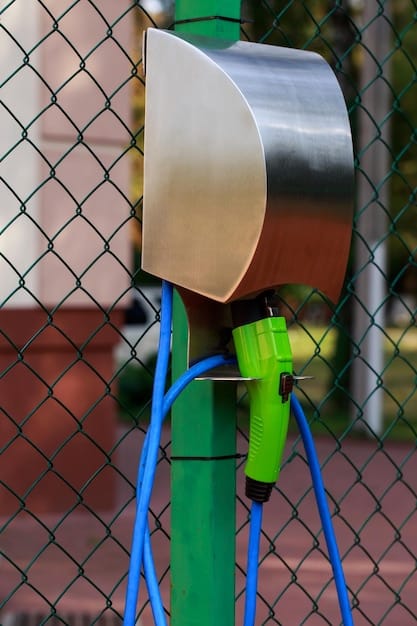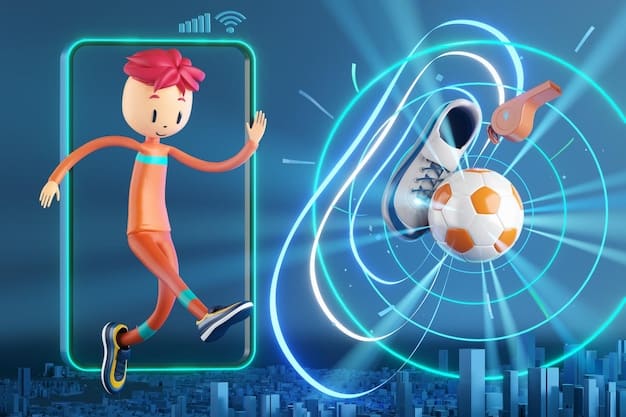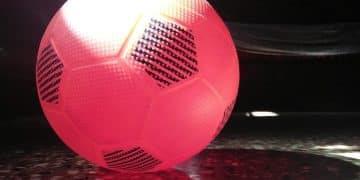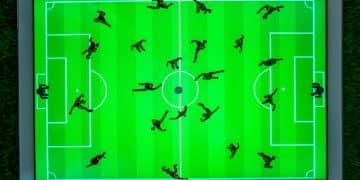Goal-Line Technology: Innovations in US Soccer

What are the Latest Innovations in Goal-Line Technology Being Used in US Soccer? These include advanced camera systems and sensor-embedded balls for precise, real-time goal detection, enhancing accuracy and fairness in professional matches.
The beautiful game is constantly evolving, and with it, so is the technology that supports it. From tracking player movement to providing instant replays, innovation plays a crucial role in modern soccer. But what are the latest innovations in goal-line technology being used in US soccer?
Goal-line technology (GLT) has become increasingly integral to ensuring fair play and accurate decision-making during matches. Let’s delve into the cutting-edge developments shaping how goals are determined in US soccer, guaranteeing that every point is earned with integrity.
Understanding Goal-Line Technology
Goal-line technology is designed to eliminate errors and increase the degree of accuracy when determining whether a ball has fully crossed the goal line. This technology is crucial for maintaining the integrity of the game, ensuring that scoring decisions are correct in critical moments.
The Evolution of GLT Systems
The current GLT systems widely used mark the newest chapter of technology in soccer. Earlier systems were inaccurate, slow, and not always reliable. Early challenges included high costs, complex setup, and occasional malfunctions. The ongoing development of GLT aims to overcome these limitations with more reliable, efficient solutions, ultimately improving soccer.
- Early Camera Systems: Initial setups used multiple high-speed cameras to track the ball’s movement near the goal line.
- Sensor-Based Systems: These involve placing sensors in the ball and around the goalposts to detect when the ball crosses the line.
- Magnetic Field Technology: An early and effective system used magnetic fields to detect if the ball crossed the line.
These advances have been essential for modernizing soccer and minimizing controversial calls that can impact game outcomes.

Current Goal-Line Technology Systems in Use
So, what are the devices actually implemented in modern soccer stadiums? Modern goal-line technology typically involves camera-based or sensor-based systems working to verify when a goal has been scored.
Camera-Based Systems
Camera-based systems are some of the most accurate available, using seven high-speed cameras positioned around the field, all focused on the goal line. Software analyzes the video feed from these cameras to pinpoint the exact location of the ball.
Sensor-Based Systems
Sensor-based systems involve placing sensors within the soccer ball and using corresponding sensors in the goalposts and crossbar. When the ball crosses the goal line, the sensors trigger a signal that alerts the referee via a specially designed smartwatch or headset.
The US soccer leagues, for example, use these camera- and sensor-based systems to provide accurate and reliable goal-line decisions. This helps maintain the integrity of the sport and ensures fair play for all participants.
The Precision of Hawk-Eye Technology
Hawk-Eye is one of the most ubiquitous systems used and provides real-time tracking and instant replay capabilities. The Hawk-Eye system uses multiple high-speed cameras positioned around the stadium to capture the ball’s exact position at all times.
Data generated by Hawk-Eye systems is not only useful to referees. The data can also be used by teams to analyze player movement and strategy. Broadcasters also benefit from Hawk-Eye data, which they use to augment live game coverage.
These features make systems like Hawk-Eye an important part of modern soccer. The precision and capabilities offered by this innovation enhance the fairness, excitement, and strategic depth of the game.
- Camera Calibration: Cameras are thoroughly calibrated before each game to ensure precise measurements.
- Real-Time Data Analysis: Software processes the camera feeds in real-time to determine the ball’s location.
- Instant Replay: Referees can view instant replays to confirm goal decisions.
Sensor Technology and Smart Balls
Another innovation in goal-line technology incorporates sensor technology into soccer balls. These smart balls contain embedded sensors that can detect when a ball has fully crossed the goal line.
How Smart Balls Work
The sensors in smart balls communicate wirelessly with receivers installed in the goalposts. When the ball crosses the goal line, the sensors trigger an instant alert to the referee’s smartwatch. Referees can make immediate, data-backed decisions.
Benefits of Smart Balls
The use of smart balls eliminates the need for multiple cameras, making the system more streamlined and easier to install. This technology is particularly useful for leagues or stadiums where installing comprehensive camera systems may not be feasible. It ensures greater accuracy with minimal setup requirements.

Future Trends in Goal-Line Technology
The field of goal-line technology is always advancing. So what are the latest innovations in goal-line technology being used in US soccer and in the future? Here are some anticipated trends in GLT systems:
Artificial Intelligence (AI) Integration
AI can analyze vast amounts of data from multiple cameras and sensors to make increasingly accurate decisions. AI algorithms can learn from past games and refine goal-detection mechanisms.
Enhanced Data Analytics
Future GLT systems will likely provide more detailed data analytics, offering insights into player movements, ball trajectories, and decision-making processes. This data can be valuable for coaches, players, and fans, enriching the soccer experience.
- Improved Accuracy: AI and machine learning can refine detection algorithms.
- Real-Time Feedback: Advanced systems can offer instant insights during games.
- Data Accessibility: Broadcasters and teams will be able to access comprehensive data.
These future trends will enhance the fairness, transparency, and integrity of the sport.
| Key Point | Brief Description |
|---|---|
| ⚽ Camera Systems | Multiple high-speed cameras track the ball’s position. |
| 💡 Sensor Technology | Sensors in the ball and goalposts detect when the ball crosses. |
| 🤖 AI Integration | AI algorithms analyze data to improve accuracy. |
Frequently Asked Questions
Goal-line technology (GLT) uses cameras and sensors to determine if the ball has completely crossed the goal line. This eliminates human error and ensures accurate calls in critical moments during a game.
Goal-line technology is highly accurate, nearly eliminating the possibility of incorrect calls. Systems like camera-based Hawk-Eye and sensor-based balls provide reliable confirmation, ensuring fair play.
Challenges include the high cost of installation and maintenance, the need for precise calibration, and overcoming occasional technical malfunctions. But improvements like AI are being applied to increase reliability.
While GLT is primarily used in professional soccer due to its cost, cheaper alternatives using mobile devices are emerging. These could make the technology more accessible to lower leagues.
Future innovations, such as AI integration and enhanced data analytics, promise greater accuracy, real-time insights, and more detailed data for coaches, players, and fans of **What are the Latest Innovations in Goal-Line Technology Being Used in US Soccer?**.
Conclusion
In conclusion, goal-line technology has revolutionized soccer, ensuring fair and accurate decisions during matches. From camera-based Hawk-Eye systems to sensor-embedded smart balls, technology continues to enhance the sport.
As what are the latest innovations in goal-line technology being used in US soccer?, like AI integration and enhanced data analytics, continue to develop, the integrity and excitement of the game will be enhanced.





